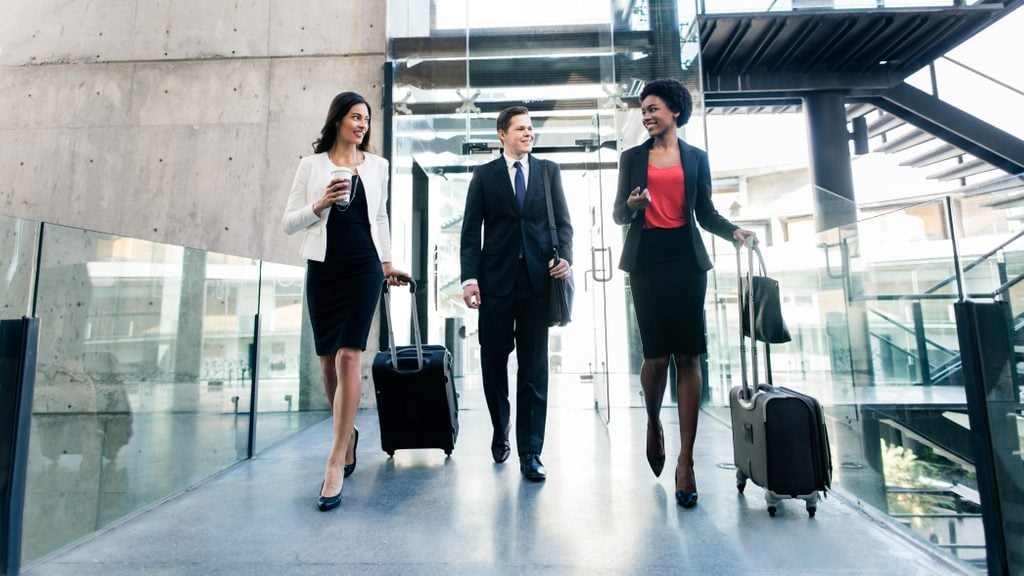Business Travel: Read This Before You Have to Travel for Work
Updated: Jul. 06, 2022

From navigating an airport and a rental car line to finding healthy food options along the way, traveling for work may seem daunting to an employee who hasn't done it before. But with a few tips from the pros, business travel can actually be an enjoyable experience.
Millennials have famously coined the term “bleisure,” a fun combination of business and leisure, which promotes the idea that business travel can include fun parts as well. Although it doesn’t always work for employees on a strict schedule, almost anyone can integrate a bit of bleisure into their business trips. Whether your next trip is strictly leisure, or in the bleisure category, make sure you never do these things in your hotel room.
How do you go on a business trip?
Business travel simply means your presence is needed in another location outside of your hometown for the work you are completing. Typically, it consists of meeting with clients or co-workers in a different office or attending an enrichment training or conference within your field.
What is the purpose of a business trip?
In the age of Skype, Microsoft Teams, conference calls, and other digital platforms, one might wonder what the purpose is of business travel at all. However, in some fields the face to face meeting is irreplaceable. Any great sales executive will vouch for the power of an in-person meeting, including the ability to read body language and adjust your pitch, and similar benefits.
John E. DiScala, known as “Johnny Jet,” a Forbes‘ Top 10 Travel Influencer, shares that meeting in person can help one avoid all the awkwardness that often accompanies a conference call. “A business trip can also strengthen existing relationships and create new ones. In this digital age, we spend so much time on devices and communicating via email, text and even social media, that it’s nice and oftentimes more productive to interact in real life.”
How can I prepare for a business trip?
It’s all in the preparation. Chris Lopinto, president and co-founder of ExpertFlyer.com, an online airline travel information website whose primary customers are frequent business travelers, suggests paying attention to your packing by choosing conservative clothing in neutral colors like black, white, and gray. “Then you can mix and match and take fewer clothes; this could be the difference between packing a carry on or checking a suitcase,” he says. Having a checklist of essentials to remember will ensure you aren’t the frazzled traveler at the security entrance scrambling to find your boarding pass or passport.
Where can I travel for business?
Your company will direct you on the specific location they need you to drive or fly to for business travel, but in some cases, you can propose a trip or request a meeting you would like to attend. “The most common business travel destinations are big financial cities like New York, Chicago, London, San Francisco, Hong Kong, and Tokyo,” DiScala says. “Other common destinations are where large conferences take place like Las Vegas, Orlando, Miami, Phoenix, Los Angeles, and San Diego.”
How can I make my business travel easier?
Lopinto recommends not settling for a seat on a flight that you may not be happy with, whether that is an aisle seat or a window seat. He also cautions travelers that it’s no longer very easy to upgrade your section on a plane. “There is no way to “beat” the system anymore and many times the airlines would rather sell the premium seat than give it away as an upgrade. The only other option for those that are casual flyers without status is to hope for an upgrade offer at the airport check-in kiosk, which there is no guarantee of,” he said.
DiScala adds that “The best way to make business travel more enjoyable is to figure out ways to avoid long lines at the airport and tight seats on the airplane. Business travelers should immediately sign up for Global Entry to avoid immigration lines when returning to the U.S. and it also comes with TSA Pre[check], so they have shorter security lines and don’t have to take their shoes off or laptop or liquids out of their bags.” He also recommends CLEAR, which uses biometrics and allows travelers to cut to the front of the security lines in select airports (and stadiums).”
